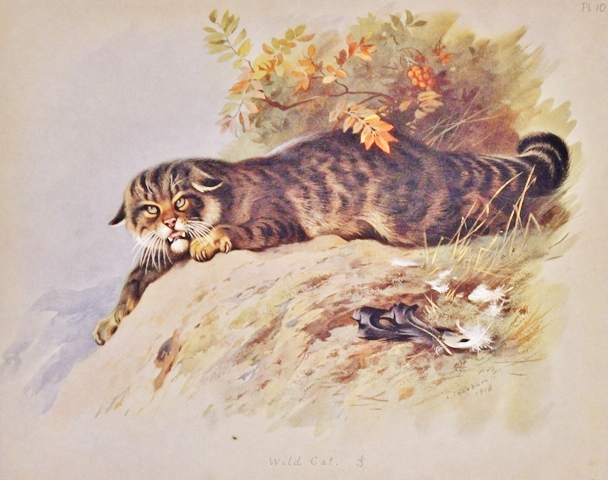
The persecution of cats in Western Europe during the Witch Craze is widely known. Under Christian influence cats were considered agents of the devil or witches in disguise. The terrifying specter of the cat may have pre-Christian antecedents in Celtic countries however. The legend of “King Arthur and the Cat,” though recorded well into Christian times, may reveal something about earlier Celtic attitudes toward the cat, attitudes possibly influenced by interactions with the indigenous wildcat.
The story begins with a fisherman alone in his boat making a vow to offer the first fish he catches to the Lord. But the first catch is unusually fine, so the fisherman hedges and says he will donate the second fish. The second fish is even bigger than the first, so the third catch is then offered. The third fish, however, is not a fish at all, but a small black kitten. The fishermen has need of a mouse catcher, so this third catch does not go to the Lord but is taken to the man’s home.
The kitten grows into a giant cat who eventually strangles the fisherman and his family, then escapes into the countryside where he wreaks havoc, taking many lives. The populace lives in terror and the land becomes desolate.
Eventually Merlin intervenes and enlists the aid of King Arthur. It takes both Merlin’s magic and Arthur’s courage to vanquish the cat, who attacks so persistently that the feet of the dead cat remain fastened to Arthur’s shield.
This fourteenth century French tale has parallels in the eleventh century Irish Voyage of Mael Duin and the sixteenth century English short story Beware the Cat. In all of these stories there is a fierce, implacable cat who takes human life. The cat in these cases does not follow the witch hunter’s narrative as a devilish seducer of the innocent: he is an agent of retribution for a serious offense against Celtic morality. In King Arthur and the Cat the sin is a broken vow, in Beware the Cat it is a brutal raid, and in Voyage of Mael Duin it is a violation of hospitality. The savage cat is not an expression of evil, but of justice.
The webinar “Magical History of the Cat” has been rescheduled for Monday, November 24th, so there’s still time to register. Details are at the webinar website.
Sources
“An Irish Odyssey: The Voyage of Mael Duin” in Celtic Mythology. New Lanark, Scotland: Geddes and Grosset, 1999.
Baldwin, William. Beware the Cat.
“Wilde, Lady Francesca Speranza. “King Arthur and the Cat” in Ancient Legends, Mystic Charms, and Superstitions of Ireland.
